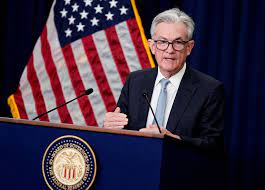The U.S. Federal Reserve is planning to increase interest rates at their upcoming meeting on May 2-3. However, they are closely monitoring key data, such as a survey of bank lending officers, to assess the risks facing the U.S. economy. This data may shape their decision on whether to pause further increases.
The collapse of Silicon Valley Bank on March 10th raised concerns about the willingness of financial firms to provide credit to businesses and households. As a result, Fed officials increased their monitoring of liquidity, and they have been checking daily to ensure all banks have the necessary paperwork to borrow quickly from different Fed facilities should it be necessary.
In the three weeks following the SVB collapse, overall bank credit fell about 1.5%, and there were initial outflows of deposits from smaller banks to larger ones. However, these flows quickly stabilized.
Although there was some initial turbulence, bank credit fell only slightly, and the lending impact seemed to be regionalized rather than a nationwide credit crash.

The Fed officials are optimistic that the worst problems have been avoided, and investors are expecting the Fed to follow through with its tenth consecutive rate hike, which would raise the benchmark interest rate to between 5% and 5.25%.
Investors are predicting that the next rate hike by the Fed will be the last one, even though some important data won’t be available until after the meeting.
Since the last meeting, the economy has shown signs of weakening, and inflation appears to be slowing down. However, the job market remains robust, and wages are increasing faster than expected. Inflation remains persistent in key areas of the service industry, which is concerning to Fed officials.
The Fed will receive updated information on the Personal Consumption Expenditures price index, which is used to set the 2% inflation target, and the Employment Cost Index, which provides insight into employment-related cost trends. The Senior Loan Officer Opinion Survey will also be released, which is seen as a leading indicator of lending trends.
This survey could influence the Fed’s view on whether the economy and inflation are likely to slow down more quickly than expected, and whether interest rates need to be increased further. The last SLOOS survey indicated that loan conditions were tightening, although some types of credit to businesses and households continued to grow.
US Federal Reserve to hike interest rates
According to economists, the upcoming survey is expected to show that lending conditions are getting tighter, and bank credit is declining.
For the Fed, the challenge is to determine whether this is just the expected impact of a year of record-setting rate hikes finally being felt in the economy or something more concerning that goes beyond what’s necessary to control inflation.
Ryan Sweet, the Chief U.S. Economist at Oxford Economics, recently wrote that the last survey indicates a decrease in business investment later this year, and the risks continue to be tilted toward a larger hit to GDP.

Banks may continue to tighten lending standards, which would limit credit access, hurt business investment, reduce business formation, and weigh on job growth and consumer spending.
The impact of the US Fed’s decisions is uncertain and may vary depending on the specific policies implemented.
The Fed is currently facing a complex economic situation with conflicting data on inflation, employment, and economic growth. Some economists predict that the Fed may raise interest rates to combat inflation, while others believe that raising rates too quickly could harm the economy.
The Fed’s rate decisions not only impact the U.S. economy, but also have global implications.
The U.S. dollar is a dominant currency in global trade and finance, and changes in U.S. interest rates can affect the value of the dollar relative to other currencies, as well as capital flows to and from other countries. This can have both positive and negative effects on global economic growth and financial stability.











